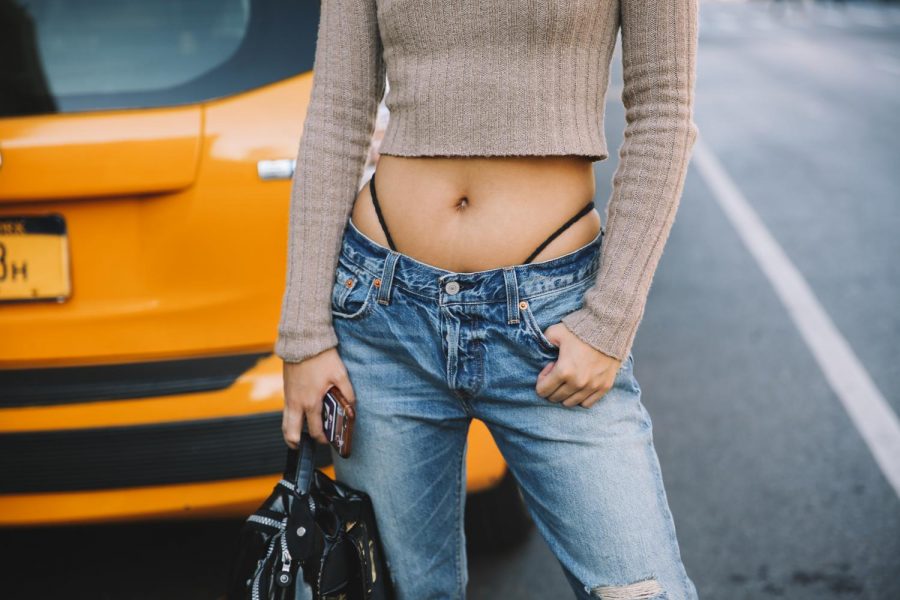Testing the Exposed Thong Trend
Low-rise pants paired with an exposed thong are now trending once again, and seem to walk the line between appreciating and exploiting the body.
October 10, 2017
More than just a daunting prospect for our lower stomachs, the trend of wearing low-rise pants with an exposed thong seems to hit perfectly on the bony line between appreciation of the body and its exploitation. The trend, which was popular in the late 1990s to early 2000s, is back on the runways and streets, according to a Vogue article. For all of its aughts glory, the look calls into question the role of the fashion industry and the practicality of using the runway as our standard for fashion.
Like the lack of representation in runway shows, the influences for this trend are whitewashed. It was, in essence, branded by celebrities such as Christina Aguilera and Paris Hilton. At the same time that Aguilera and Hilton were building their empires, artists of color were equally if not more so influential — but world-famous models like Tyra Banks and Naomi Campbell were excluded from the trendsetting.
In America, especially now as we try to address issues of racial inclusion, contributions from people of color are very often afterthoughts. It is rare to find articles that boast the creation of black success and innovation ,artistic or otherwise, and easier to find historical accounts of black Americans simply observing the growth of white enterprises. A black artist will be the sidekick, will be the helper, the token but never the owner.
It may seem like a stretch, but a visible thong shows the cracks in America’s striving for equality. The concept of sagging — which is quintessentially what makes this look — existed in black American communities before the 2000s.
At NYU, students were not against the thong trend, but not on-board for it themselves. Steinhardt graduate student Constanza Valenzuela, said that she wouldn’t wear the trend because it doesn’t suit her body type or style, and Sydney Hiller, a CAS senior, was equally unenthusiastic about the look.
“It’s just not a relatable fashion,” Hiller said. Dressed in a maroon top and black jeans, a gold necklace swinging from her neck, she also noted the increasing level of exposing clothing, touching on the thought that fashion, in its artistic form, is removed from the social biases that actually dressing does. Adding meaning to clothing can liberate, as is the case with Hiller and Valenzuela’s decisions.
On the other hand, when clothing has meaning, it often presses onto the wearer like dye, and people are quick to judge sensuality, especially when it is unexpected — like when a thong shows at the top of one’s jeans.
Gallatin freshman Annette Yoo and I decided to test this theory and try hip-baring outfits for ourselves, accompanied by Gallatin freshman Sam Cheng, our photographer for our personal photoshoot. Yoo’s initial impression was that wearing her underwear in this way brought unwanted attention to herself.
“It was interesting to be strutting around [New York City] and feel eyes immediately going down to look at my very obviously exposed underwear,” Yoo said. “I was honestly uncomfortable with this attention at first.”
While Yoo said she appreciated the sexiness of the look, she thought that she would only wear it on her boldest days to a themed party or a bar. Again, here the concern is the occasion to which the outfit would be acceptable and comfortable. Yoo chose not to wear the look at least in part, slipping the thong out of sight until reaching the photoshoot, out of concern for personal safety. According to both Yoo and Cheng, there was an excessive amount of catcalling in response to the outfit. This brings up the sinister paradox that is common to all women. Do we own our sexiness in public spaces? Can we be empowered by being scantily clad, promiscuous and hip-bearing?
Yoo summed up the trend as a style intended to be overtly sexy.
“I definitely see [this trend] as more as a sexualization of the body, especially through the attention I got from wearing this around; attention I don’t normally get as fervently,” Yoo said. “It appreciates the female body by bringing attention to the feminine hips and the visible lingerie, but it is definitely an appreciation through sexualization.”
As the second participant in this fashion-turned-social science experiment, I wanted to explore the variability of the trend. I wore army green khakis that were at least two sizes too large. To accentuate my hips in accordance with the trend, I wore royal blue Ford boxer shorts. Even though I chose to pair the look with a low-cut, cropped blouse, my outfit was far more masculine than Annette’s.
Walking down Astor Place, my first worry was that my pants would simply slide right off. I also put considerable effort into sucking in my stomach, and trying to find my hipbones by standing up straight — extremely straight. I still had trouble seeing my bones, and I knew a thinner style of underwear would have cut into the sides of my hips. Yet I was still able to take part in this trend. I knew my limits. I knew what would make me uncomfortable, and what I would continually be adjusting.
In short, I enjoyed this look. I loved the casual style the exposed boxers brought. I felt sexy because of how my body was moving in the outfit. Once I got over the fear of inadvertently pants-ing myself in the middle of the city, I began to appreciate that, although a key part, this look didn’t rely on bareness. With the purposeful slouch, the look falls around the body, instead of covering, coveting that it shrunk.
The variability of this look means that it can be worn by a variety of people. Everyone, man to woman and beyond, has the right to feel sexy, and to take ownership of their promiscuity. With this look, you need only stay true to your personal style, your mood and your destination.
It is necessary, however, to return to the matter of race in terms of this trend. While white fashionistas and artists wear their pants low in luxury circles, contributions by talented people of color are either ignored or given no credit.
According to Gene Demby for NPR, multiple municipalities have criminalized sagging. A problem, Demby said, because it once again puts black men at greater risk for legal trouble. Floridian council member Mary Sue Rich, was quoted by Demby as saying “I would wager [nine] out of 10 of [people who sag their pants] don’t have jobs.” This impromptu statistic is more of an indication of Rich’s racism than a learned political statement. The common denominator in Rich’s “wager” is that sagging is a black fashion, no matter your artistic opinions on it.
Demby points out that people use these same arguments against hip-hop and rap music. I also see similar arguments concerning what a woman choses to wear. It is not possible to dismiss this as a personal taste issue. Cringing at a badly put-together outfit comes from the bias of one’s fashion sense. Attempts to control how women, women of color and non-femme people of color dress comes from the prejudices of a gender and race, respectively.
As with judging another’s outfit, there is the rather narcissistic assumption that you know more about fashion than them, so too does the attempt to control women and people of color indicate the sentiment that they are not equally capable of managing their autonomy.
Yet there is a difference. As a woman, I do worry about my safety. As a white woman, I don’t have to worry about people judging my entire race based on the height of my belt loops or how much of my skin I show. As a white woman who loves fashion and design, I am racially represented in the industry I love. I sag my pants and write an article about it. A black man or woman wears the same and is demonized.
White and white-passing women need only reclaim their sexual autonomy. Black artists have to also reclaim their artistic history. It comes down to choice — to comfort.
Wear what you want. Pull your thong up to your hip bones, and sink your pants lower than law would abide. See the resurfacing of trends as collaborative processes, from people of all backgrounds. Claim your rightful space for your body and your art in the fashion industry.
A version of this article appeared in the Tuesday, Oct. 10 print edition. Email Naomi Lichter at [email protected].


























































































































































Igor Poika • Apr 10, 2018 at 12:07 am
IT TOTALLY makes my day when I can see the thong above the pant line – even to see a little V above the pant line when girls bend over is Sssooo AMAZING woweeeeee and I know all my many friends think the same way so PLEASE girls can we see the little V or even a little thong strap at the back – nothing wrong with that at all it just looks Sssssssoooo SEXY